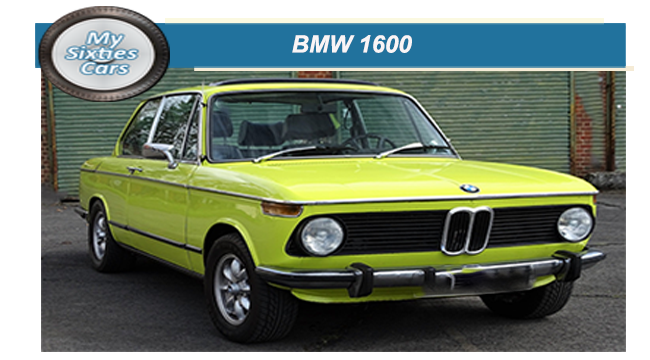 While the 1500 saloon, released almost three years earlier as the first of the New Class" from BMW with considerable critical success, it is generally acknowledged that the 1600 was the first major building block in BMW's ultimate popularity not only in the domestic market but also for export, especially the USA.
While the 1500 saloon, released almost three years earlier as the first of the New Class" from BMW with considerable critical success, it is generally acknowledged that the 1600 was the first major building block in BMW's ultimate popularity not only in the domestic market but also for export, especially the USA.
Introduced in March 1964, the BMW 1600 was powered by 1.6-liter overhead-cam engine generating 85-horsepower.
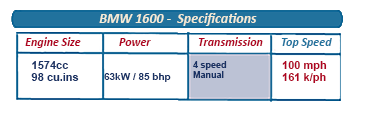 BMW had apparently learned their lessons from the 1500, which was reportedly underpowered. With the 1600 they had developed the largest four-cylinder engine they could must and installed into a petite body.
BMW had apparently learned their lessons from the 1500, which was reportedly underpowered. With the 1600 they had developed the largest four-cylinder engine they could must and installed into a petite body.
The first major power update on the 1600 was achieved by taking the pistons from the 1800’s engine to enlarge that used in the 1500.
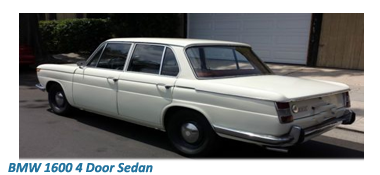 This relatively straightforward update, pushed the engine’s power up to 1573 cc, meaning that it could now generate 85 bhp, which was a lot of power for such a small car.
This relatively straightforward update, pushed the engine’s power up to 1573 cc, meaning that it could now generate 85 bhp, which was a lot of power for such a small car.
The BMW 1600 was initially launched as a two-door saloon, with a wheelbase two inches shorter than the four-door sedans that followed shortly after.
![]()
Styling features for the 1600 included round headlamps at the ends of horizontal-bar side grilles, in a typical angled-forward front end with wraparound park/signal lamp while fog lamps were an optional extra.
 In keeping with previous design standars, round tail lamps were used, with a BMW emblem and '1600' legend on the right of the back panel.
In keeping with previous design standars, round tail lamps were used, with a BMW emblem and '1600' legend on the right of the back panel.
From 1967, the 1600-2 designation changed to 1602 in Europe, although two-doors were still labelled the 1600 in the U.S.
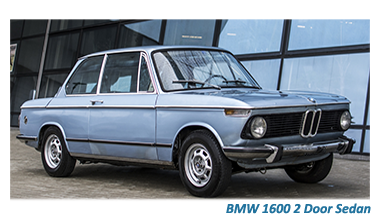 In September of 1967, BMW launched a convertible version of the 1600, with production farmed out to Karosserie Baur company of Stuttgart.
In September of 1967, BMW launched a convertible version of the 1600, with production farmed out to Karosserie Baur company of Stuttgart.
The soft top enjoyed minor success, entirely in the domestic market as it did not pass the stringent tests to allow import into the US.
For those who on the look out for a little more oomph, BMW added was a 1600ti version, which again sold well in Europe but did not come to the U.S market.
The BMW 1600ti’s came fitted with an engine with higher compression and twin carburettors. Buyers could opt for either four-speed or five-speed manual transmission.
Despite the companys best efforts, the BMW 1600 sedan was not a commercial success meaning that its production run was short-lived, from 1964 to 1968.
![]()
Ultimately the 1600 was totally overshadowed by the 1800, launched at the same time, which was so much more powerful and therefore more in demand.
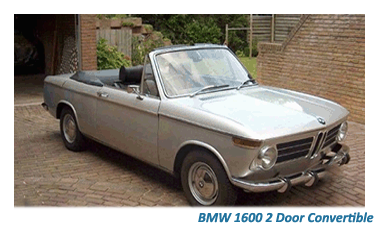 On the other hand, the 1600 coupe proved to be the real success story of the series m thanks to its cleaner lines and more powerful engine, with an 11-hp boost for its 1.6L 4-cylinder inline engine and featured a more sportive look.
On the other hand, the 1600 coupe proved to be the real success story of the series m thanks to its cleaner lines and more powerful engine, with an 11-hp boost for its 1.6L 4-cylinder inline engine and featured a more sportive look.
The BMW 1600 2-door coupe sold close to a quarter of a million models and ran on well into the Seventies when it was finally replaced by the 2002 coupe.






